Hydrochemical Evolution Mechanisms of Shallow Groundwater and Its Quality Assessment in the Estuarine Coastal Zone: A Case Study of Qidong, China
Abstract
1. Introduction
2. Materials and Methods
2.1. Study Area
2.2. Sampling and Measurement
3. Results
3.1. Hydrochemical Constituents of Shallow Groundwater
3.2. Hydrochemical Types of Shallow Groundwater and Its Spatial Distribution
3.3. Geospatial Distribution of Key Ions in Coastal Zone
4. Discussion
4.1. Hydrochemical Evolution Mechanisms
4.2. Evaluation of Groundwater Suitability in Drinking and Irrigation
5. Conclusions
Author Contributions
Funding
Acknowledgments
Conflicts of Interest
Appendix A
| Sample | Indicator/mg·L−1 | |||||||||||
|---|---|---|---|---|---|---|---|---|---|---|---|---|
| Type | Na+ | K+ | Ca2+ | Mg2+ | Cl− | HCO3− | SO42− | NO3− | NH4+ | TDS | ||
| 3 | Huiping Town | Cl-Na | 113.0 | 130 | 36.8 | 22.7 | 203.6 | 168.4 | 36.2 | 0.41 | 1.24 | 601.00 |
| 11 | Wucang Port | Cl-Na | 2210.0 | 125.3 | 90.1 | 177.4 | 3780.0 | 151.3 | 179.6 | 1.18 | 0.65 | 6690.00 |
| 17 | Xiexing Port | Cl-Na | 8200.0 | 350.0 | 308.0 | 572.0 | 13,800.0 | 87.9 | 844.4 | 0.73 | 0.34 | 30,000.00 |
| 30 | Lvsi Town | HCO3 -Ca·Mg | 41.8 | 9.1 | 37.8 | 11.3 | 71.2 | 133.0 | 35.5 | 1.11 | 0.59 | 324.00 |
| 3832 | Sanhe Port | HCO3 -Ca·Mg | 33.1 | 7.7 | 34.0 | 10.2 | 47.9 | 119.6 | 31.5 | 1.38 | 0.06 | 273.00 |
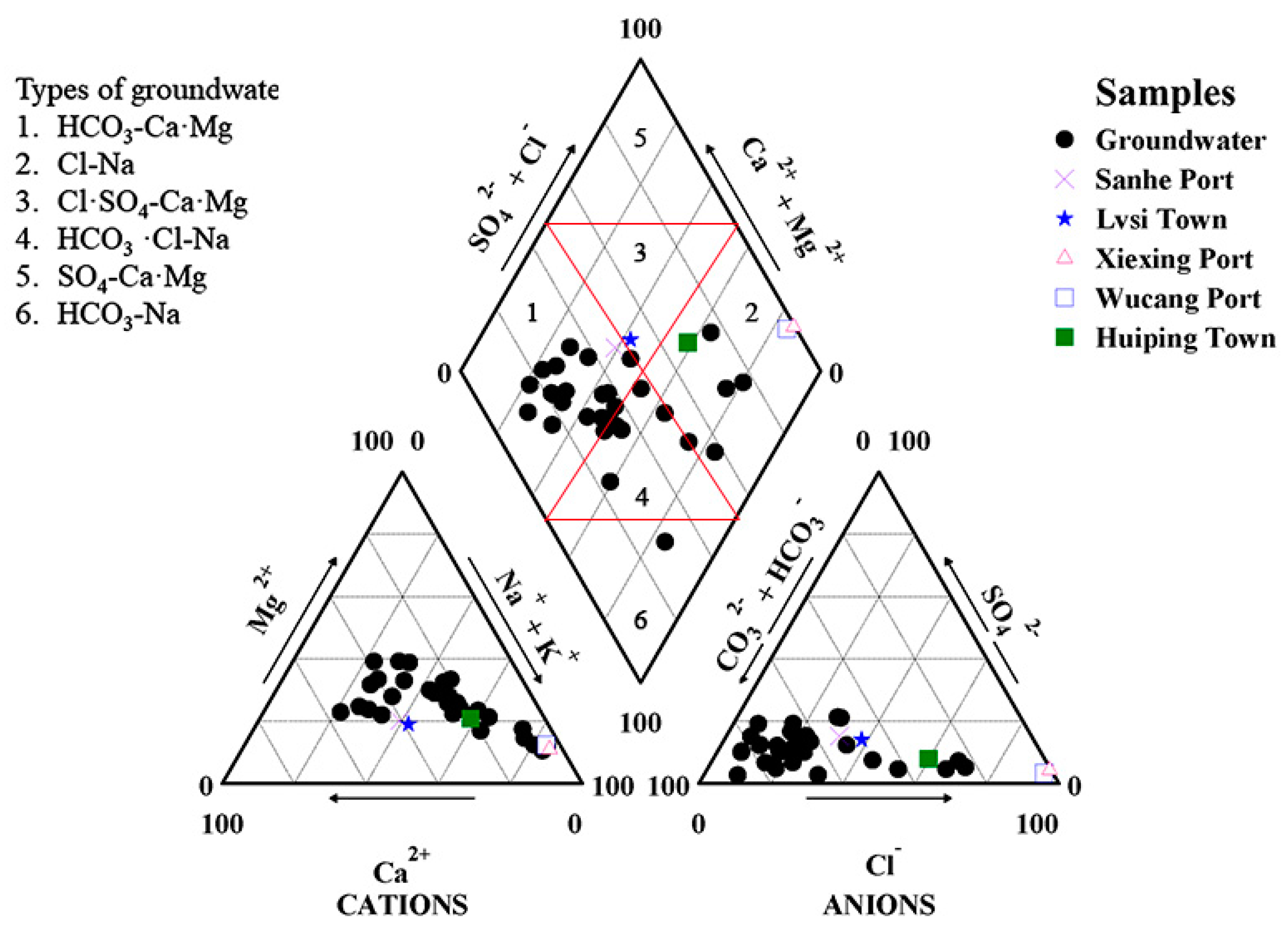
References
- Lei, S.; Jiao, J.J. Seawater intrusion and coastal aquifer management in China: A review. Environ. Earth Sci. 2014, 72, 2811–2819. [Google Scholar]
- Fetter, C.W. Applied Hydrogeology: International Edition; Person: London, UK, 2001. [Google Scholar]
- Mohanty, A.K.; Rao, V.V.S.G. Hydrogeochemical, seawater intrusion and oxygen isotope studies on a coastal region in the Puri District of Odisha, India. Catena 2019, 172, 558–571. [Google Scholar] [CrossRef]
- Werner, A.D.; Bakker, M.; Post, V.E.A.; Vandenbohede, A.; Lu, C.; Ataie-Ashtiani, B.; Simmons, C.T.; Barry, D.A. Seawater intrusion processes, investigation and management: Recent advances and future challenges. Adv. Water Resour. 2013, 51, 3–26. [Google Scholar] [CrossRef]
- Pulido-Leboeuf, P. Seawater intrusion and associated processes in a small coastal complex aquifer (Castell de Ferro, Spain). Appl. Geochem. 2004, 19, 1517–1527. [Google Scholar] [CrossRef]
- Seawater Intrusion in Coastal Aquifers—Concepts, Methods and Practices; Bear, J., Cheng, H.D., Sorek, S., Ouazar, D., Herrera, I.J.T., Eds.; Springer: Berlin, Germany, 1999; p. 14. [Google Scholar]
- Psychoyou, M.; Mimides, T.; Rizos, S.; Sgoubopoulou, A.J.D. Groundwater hydrochemistry at Balkan coastal plains—The case of Marathon of Attica, Greece. Desalination 2007, 213, 230–237. [Google Scholar] [CrossRef]
- Helstrup, T.; Jørgensen, N.O.; Banoeng-Yakubo, B. Investigation of hydrochemical characteristics of groundwater from the Cretaceous-Eocene limestone aquifer in southern Ghana and southern Togo using hierarchical cluster analysis. Hydrogeol. J. 2007, 15, 977–989. [Google Scholar] [CrossRef]
- Mondal, N.C.; Singh, V.P.; Singh, S.; Singh, V.S. Hydrochemical characteristic of coastal aquifer from Tuticorin, Tamil Nadu, India. Environ. Monit. Assess. 2011, 175, 531–550. [Google Scholar] [CrossRef]
- Selvam, S.; Manimaran, G.; Sivasubramanian, P. Hydrochemical characteristics and GIS-based assessment of groundwater quality in the coastal aquifers of Tuticorin corporation, Tamilnadu, India. Appl. Water Sci. 2013, 3, 145–159. [Google Scholar] [CrossRef]
- Su, Y.-H.; Feng, Q.; Zhu, G.-F.; Si, J.-H.; Zhang, Y.-W. Identification and evolution of groundwater chemistry in the ejin sub-basin of the heihe river, northwest china1 1 project supported by the national natural science foundation of china (Nos. 40671010 and 40501012). Pedosphere 2007, 17, 331–342. [Google Scholar] [CrossRef]
- Hamed, Y.; Dhahri, F. Hydro-geochemical and isotopic composition of groundwater, with emphasis on sources of salinity, in the aquifer system in Northwestern Tunisia. J. Afr. Earth Sci. 2013, 83, 10–24. [Google Scholar] [CrossRef]
- Carol, E.; Kruse, E.; Mas-Pla, J. Hydrochemical and isotopical evidence of ground water salinization processes on the coastal plain of Samborombón Bay, Argentina. J. Hydrol. 2009, 365, 335–345. [Google Scholar] [CrossRef]
- Salem, Z.E.; Al Temamy, A.M.; Salah, M.K.; Kassab, M. Origin and characteristics of brackish groundwater in Abu Madi coastal area, Northern Nile Delta, Egypt. Estuar. Coast. Shelf Sci. 2016, 178, 21–35. [Google Scholar] [CrossRef]
- Yang, Q.; Xiao, H.; Zhao, L.; Yang, Y.; Li, C.; Zhao, L.; Yin, L. Hydrological and isotopic characterization of river water, groundwater, and groundwater recharge in the Heihe River basin, northwestern China. Hydrol. Process. 2011, 25, 1271–1283. [Google Scholar] [CrossRef]
- Medici, G.; West, L.J.; Chapman, P.J.; Banwart, S.A. Prediction of contaminant transport in fractured carbonate aquifer types: A case study of the Permian Magnesian Limestone Group (NE England, UK). Environ. Sci. Pollut. Res. 2019, 26, 24863–24884. [Google Scholar] [CrossRef]
- Kammoun, S.; Trabelsi, R.; Re, V.; Zouari, K.; Henchiri, J. Groundwater quality assessment in semi-arid regions using integrated approaches: The case of Grombalia aquifer (NE Tunisia). Environ. Monit. Assess. 2018, 190, 87. [Google Scholar] [CrossRef]
- Xanke, J.; Goeppert, N.; Sawarieh, A.; Liesch, T.; Kinger, J.; Ali, W.; Hötzl, H.; Hadidi, K.; Goldscheider, N. Impact of managed aquifer recharge on the chemical and isotopic composition of a karst aquifer, Wala reservoir, Jordan. Hydrogeol. J. 2015, 23, 1027–1040. [Google Scholar] [CrossRef]
- Bouzourra, H.; Bouhlila, R.; Elango, L.; Slama, F.; Ouslati, N. Characterization of mechanisms and processes of groundwater salinization in irrigated coastal area using statistics, GIS, and hydrogeochemical investigations. Environ. Sci. Pollut. Res. 2015, 22, 2643–2660. [Google Scholar] [CrossRef]
- Gibbs, R.J. Mechanisms controlling world water chemistry. Science 1970, 170, 1088–1090. [Google Scholar] [CrossRef]
- Barlow, P.M.; Reichard, E.G. Saltwater intrusion in coastal regions of North America. Hydrogeol. J. 2010, 18, 247–260. [Google Scholar] [CrossRef]
- Vandenbohede, A.; Lebbe, L. Occurrence of salt water above fresh water in dynamic equilibrium in a coastal groundwater flow system near De Panne, Belgium. Hydrogeol. J. 2006, 14, 462–472. [Google Scholar] [CrossRef]
- Ghiglieri, G.; Carletti, A.; Pittalis, D. Analysis of salinization processes in the coastal carbonate aquifer of Porto Torres (NW Sardinia, Italy). J. Hydrol. 2012, 432, 435–451. [Google Scholar] [CrossRef]
- Wang, Y.; Jiao, J.J. Origin of groundwater salinity and hydrogeochemical processes in the confined Quaternary aquifer of the Pearl River Delta, China. J. Hydrol. 2012, 438, 1121–1124. [Google Scholar] [CrossRef]
- Sebei, A.; Slama, T.; Helali, M.A. Hydrochemical characterization and geospatial analysis of groundwater quality in Cap Bon region, northeastern Tunisia. Environ. Earth Sci. 2018, 77, 557. [Google Scholar] [CrossRef]
- Chacha, N.; Njau, K.N.; Lugomela, G.V.; Muzuka, A.N.N. Hydrogeochemical characteristics and spatial distribution of groundwater quality in Arusha well fields, Northern Tanzania. Appl. Water Sci. 2018, 8, 118. [Google Scholar] [CrossRef]
- Rabeiy, R.E. Assessment and modeling of groundwater quality using WQI and GIS in Upper Egypt area. Environ. Sci. Pollut. Res. 2018, 25, 30808–30817. [Google Scholar] [CrossRef]
- Ali, S.A.; Ali, U. Hydrochemical characteristics and spatial analysis of groundwater quality in parts of Bundelkhand Massif, India. Appl. Water Sci. 2018, 8, 39. [Google Scholar] [CrossRef]
- Brindha, K.; Elango, L. Groundwater quality zonation in a shallow weathered rock aquifer using GIS. Geo-Spat. Inf. Sci. 2012, 15, 95–104. [Google Scholar] [CrossRef]
- Vittecoq, B.; Reninger, P.A.; Violette, S.; Martelet, G.; Dewandel, B.; Audru, J.C. Heterogeneity of hydrodynamic properties and groundwater circulation of a coastal andesitic volcanic aquifer controlled by tectonic induced faults and rock fracturing—Martinique island (Lesser Antilles—FWI). J. Hydrol. 2015, 529, 1041–1059. [Google Scholar] [CrossRef]
- Liu, M.; Yang, Y.; Hou, L.; Xu, S.; Ou, D.; Zhang, B.; Liu, Q. Chlorinated organic contaminants in surface sediments from the Yangtze Estuary and nearby coastal areas, China. Mar. Pollut. Bull. 2003, 46, 672–676. [Google Scholar] [CrossRef]
- Zhao, S.; Feng, C.; Wang, D.; Tian, C.; Shen, Z.Y. Relationship of metal enrichment with adverse biological effect in the Yangtze Estuary sediments: Role of metal background values. Environ. Sci. Pollut. Res. 2014, 21, 464–472. [Google Scholar] [CrossRef]
- Song, B.; Zhang, X.; Fang, Z. Mechanism of chemical evolution for Quaternary groundwater in Yangtze River estuarine region. Acta Geogr. Sin.-Chin. Ed. 2000, 55, 218–226. [Google Scholar]
- Wang, S.; Sun, J.; Li, Z. Groundwater quality evaluation in the delta area of the Yangtze River. Hydrogeol. Eng. Geol. 2005, 32, 30–33. [Google Scholar]
- Xuan, J.L.; Huang, D.; Zhou, F.; Zhu, X.H.; Fan, X. The role of wind on the detachment of low salinity water in the Changjiang Estuary in summer. J. Geophys. Res.: Ocean. 2012, 117. [Google Scholar] [CrossRef]
- Qiao, J.; Long, J.; Xu, D. Preliminary study in geochemical characteristics of seawater intrusion in the coastal region north wing of the Yangtze River Estuary. Mar. Sci. Bull. /Haiyang Tongbao 2011, 30, 200–205. [Google Scholar]
- Li, P.; Yang, S.; Dai, S.; Zhang, W. Accretion/erosion of the subaqueous delta at the Yangtze Estuary in recent 10 years. Acta Geogr. Sin.-Chin. Ed. 2007, 62, 707. [Google Scholar]
- Bahar, M.M.; Reza, M.S. Hydrochemical characteristics and quality assessment of shallow groundwater in a coastal area of Southwest Bangladesh. Environ. Earth Sci. 2010, 61, 1065–1073. [Google Scholar] [CrossRef]
- Xiaotong, H. Study on the Coupled Numerical Simulation of Groundwater Flow, Land Subsidence and Freshwater Salinisation in Nantong Area. Master’s Thesis, Nanjing University, Nanjing, China, 2016. [Google Scholar]
- Qi, W.; Qingshan, M.; Zu, J.L. Probe into deep groundwater salinization genesis in nantong city. Coal Geol. China 2017, 29, 41–45. [Google Scholar]
- Luo, Z.J.; Zhang, Y.Y.; Shi, C.H. Three-dimensional numerical model for groundwater resource evaluation and plan in loose Quaternary sediments in Nantong. Water Resour. Prot. 2009, 25, 19–23. [Google Scholar]
- Bo, K. The Study of Groundwater Evolution and Rational Exploitation and Utilizing in Jiangsu Coastal Area. Ph.D. Thesis, Jilin University, Jilin, China, 2017. [Google Scholar]
- Hui-fang, Z.; Hong-bing, T.; Xi-ying, Z.; Wen-jie, Z.; Xue, S. Recharge source, hydrochemical characteristics and formation mechanism of groundwater in Nantong, Jiangsu Province. Geochimica 2011, 40, 566–576. [Google Scholar]
- Freeze, R.A.; Cherry, J.A. Groundwater; Prentice-Hall: Englewood Cliffs, NJ, USA, 1979. [Google Scholar]
- Lei, Z.; Yang, S.; Xu, Z.; Vachaud, G. Preliminary investigation of the spatial variability of soil properties. J. Hydraul. Eng. 1985, 9, 10–21. [Google Scholar]
- Tesoriero, A.J.; Spruill, T.B.; Eimers, J.L. Geochemistry of shallow ground water in coastal plain environments in the southeastern United States: Implications for aquifer susceptibility. Appl. Geochem. 2004, 19, 1471–1482. [Google Scholar] [CrossRef]
- Piper, A.M. A graphic procedure in the geochemical interpretation of water-analyses. Trans. Am. Geophys. Union 1944, 25, 914–928. [Google Scholar] [CrossRef]
- Hiscock, K.M.; Bense, V.F.; Hiscock, K.M.; Bense, V.F. Hydrogeology: Principles and Practice; Wiley: Hoboken, NJ, USA, 2007. [Google Scholar]
- De Montety, V.; Radakovitch, O.; Vallet-Coulomb, C.; Blavoux, B.; Hermitte, D.; Valles, V. Origin of groundwater salinity and hydrogeochemical processes in a confined coastal aquifer: Case of the Rhône delta (Southern France). Appl. Geochem. 2008, 23, 2337–2349. [Google Scholar] [CrossRef]
- Manno, E.; Vassallo, M.; Varrica, D.; Dongarrà, G.; Hauser, S. Hydrogeochemistry and water balance in the coastal wetland area of “Biviere di Gela,” Sicily, Italy. Water Air Soil Pollut. 2007, 178, 179–193. [Google Scholar] [CrossRef]
- Vengosh, A.; Rosenthal, E. Saline groundwater in Israel: Its bearing on the water crisis in the country. J. Hydrol. 1994, 156, 389–430. [Google Scholar] [CrossRef]
- Tlili-Zrelli, B.; Hamzaoui-Azaza, F.; Gueddari, M.; Bouhlila, R. Geochemistry and quality assessment of groundwater using graphical and multivariate statistical methods. A case study: Grombalia phreatic aquifer (Northeastern Tunisia). Arab. J. Geosci. 2013, 6, 3545–3561. [Google Scholar] [CrossRef]
- García, G.M.; Hidalgo, M.d.V.; Blesa, M.A. Geochemistry of groundwater in the alluvial plain of Tucuman province, Argentina. Hydrogeol. J. 2001, 9, 597–610. [Google Scholar] [CrossRef]
- Cardona, A.; Carrillo-Rivera, J.J.; Huizar-Álvarez, R.; Graniel-Castro, E. Salinization in coastal aquifers of arid zones: An example from Santo Domingo, Baja California Sur, Mexico. Environ. Geol. 2004, 45, 350–366. [Google Scholar] [CrossRef]
- Appelo, C.; Postma, D. Geochemistry, Groundwater and Pollution, 2nd ed.; August Aimé Balkema: Rotterdam, The Netherlands, 2005. [Google Scholar]
- Martínez, D.; Bocanegra, E. Hydrogeochemistry and cation-exchange processes in the coastal aquifer of Mar Del Plata, Argentina. Hydrogeol. J. 2002, 10, 393–408. [Google Scholar] [CrossRef]
- Richter, B.C.; Kreitler, C.W.; Bledsoe, B.E. Identification of Sources of Ground-Water Salinization Using Geochemical Techniques; US Environmental Protection Agency, Office of Research and Development: Washington, DC, USA, 1991; p. 273.
- Schoeller, H. Groundwater Studies—An International Guide for Research and Practice. In Geochemistry of Groundwater; UNESCO: Paris, France, 1977; Chapter 15. [Google Scholar]
- Askri, B. Hydrochemical processes regulating groundwater quality in the coastal plain of Al Musanaah, Sultanate of Oman. J. Afr. Earth Sci. 2015, 106, 87–98. [Google Scholar] [CrossRef]
- WHO. Guidelines for Drinking-Water Quality; World Health Organization: Geneva, Switzerland, 2011. [Google Scholar]
- Davis, S.N.; De Wiest, R.J. Hydrogeology; Wiley: New York, NY, USA, 1966. [Google Scholar]
- Sawyer, C.N.; McCarty, P.L. Chemistry for Sanitary Engineers; McGraw-Hill: New York, NY, USA, 1967. [Google Scholar]
- Todd, D.K. Groundwater Hydrology; Wiley: New York, NY, USA, 1980. [Google Scholar]
- Subramani, T.; Elango, L.; Damodarasamy, S. Groundwater quality and its suitability for drinking and agricultural use in Chithar River Basin, Tamil Nadu, India. Environ. Geol. 2005, 47, 1099–1110. [Google Scholar] [CrossRef]
- Richards, L.A. Diagnosis and Improvement of Saline and Alkali Soils; LWW: Philadelphia, PA, USA, 1954; Volume 78. [Google Scholar]
- Wilcox, L. Classification and Use of Irrigation Waters; US Department of Agriculture: Washington, DC, USA, 1955.
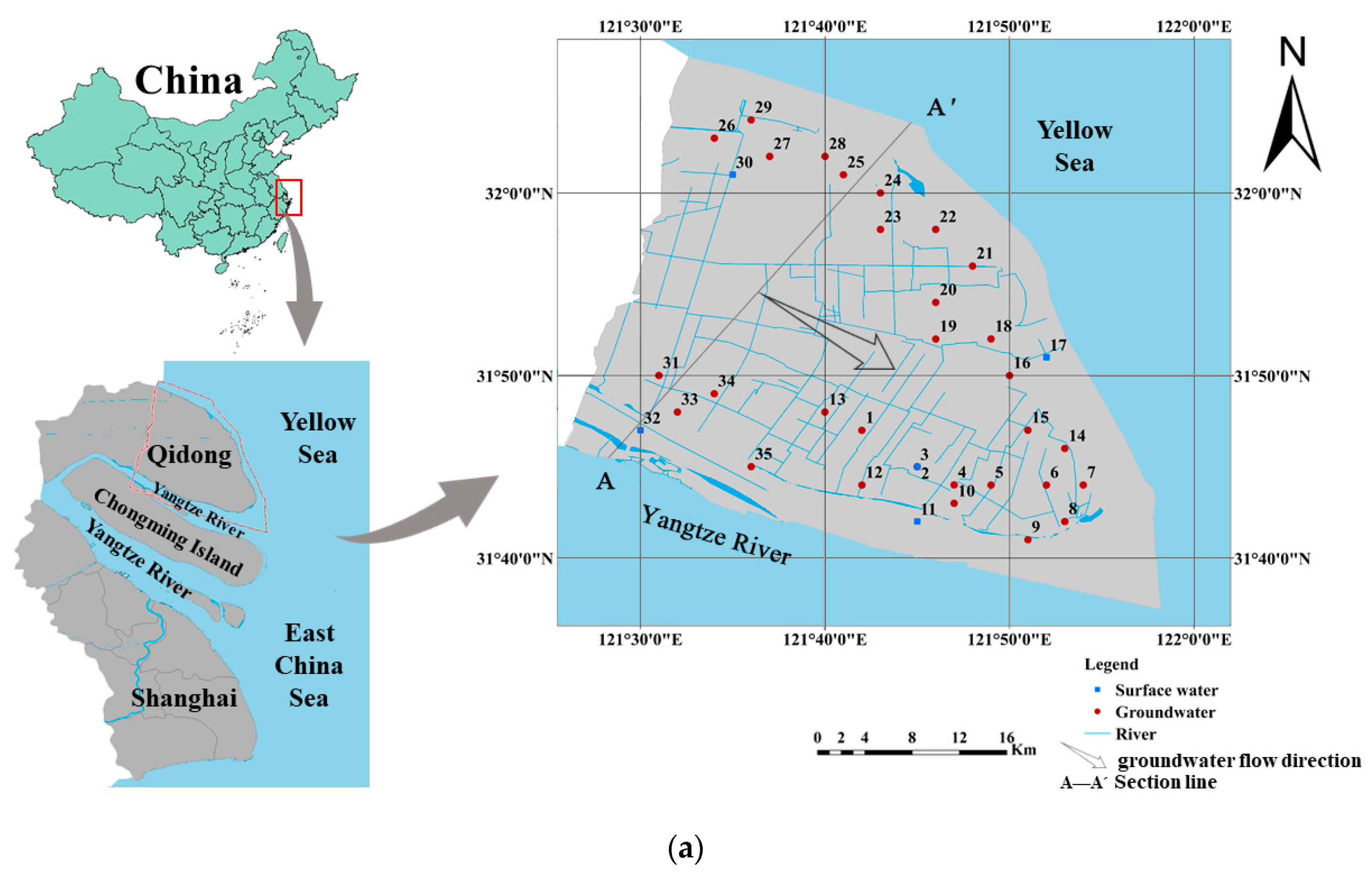
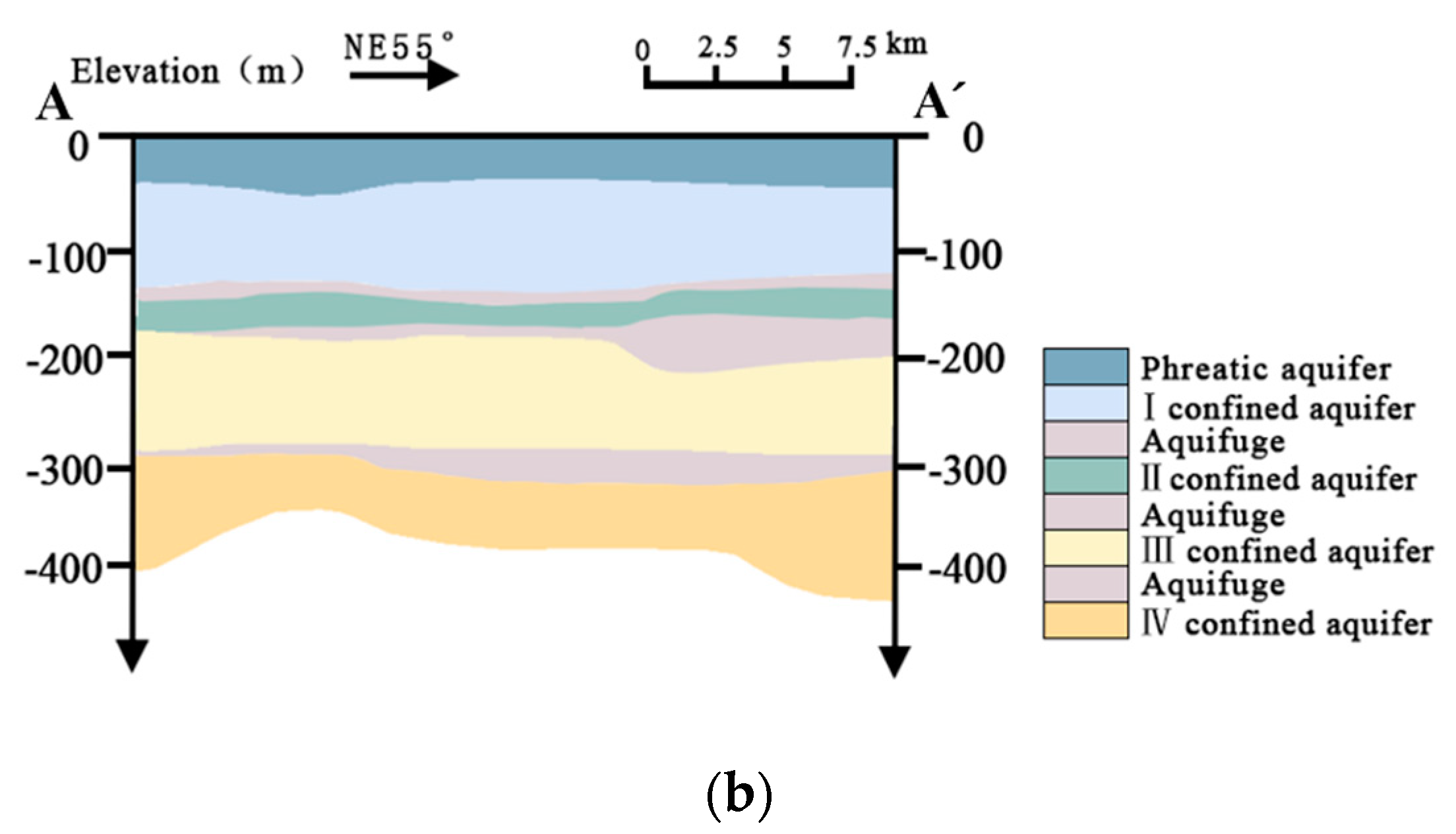
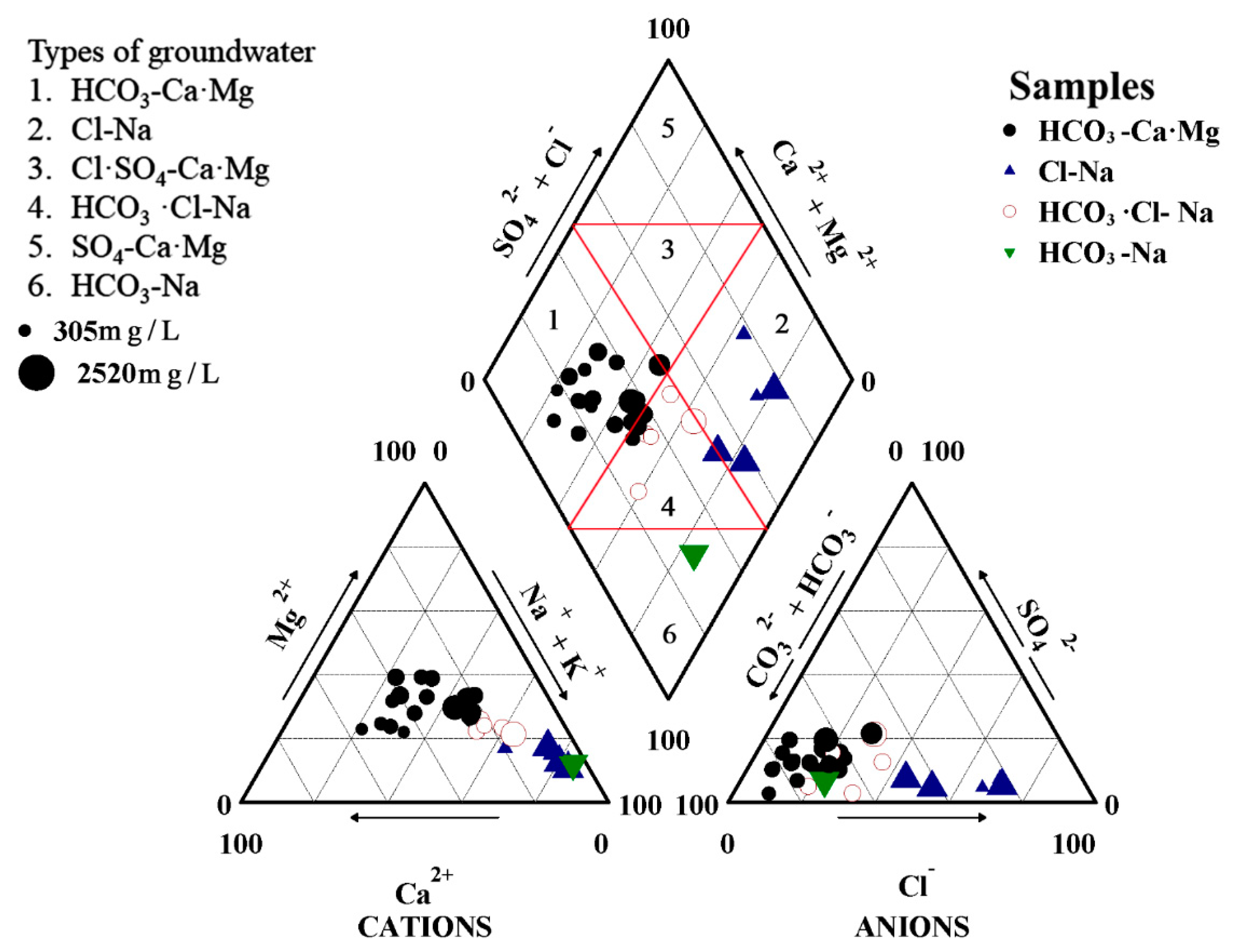
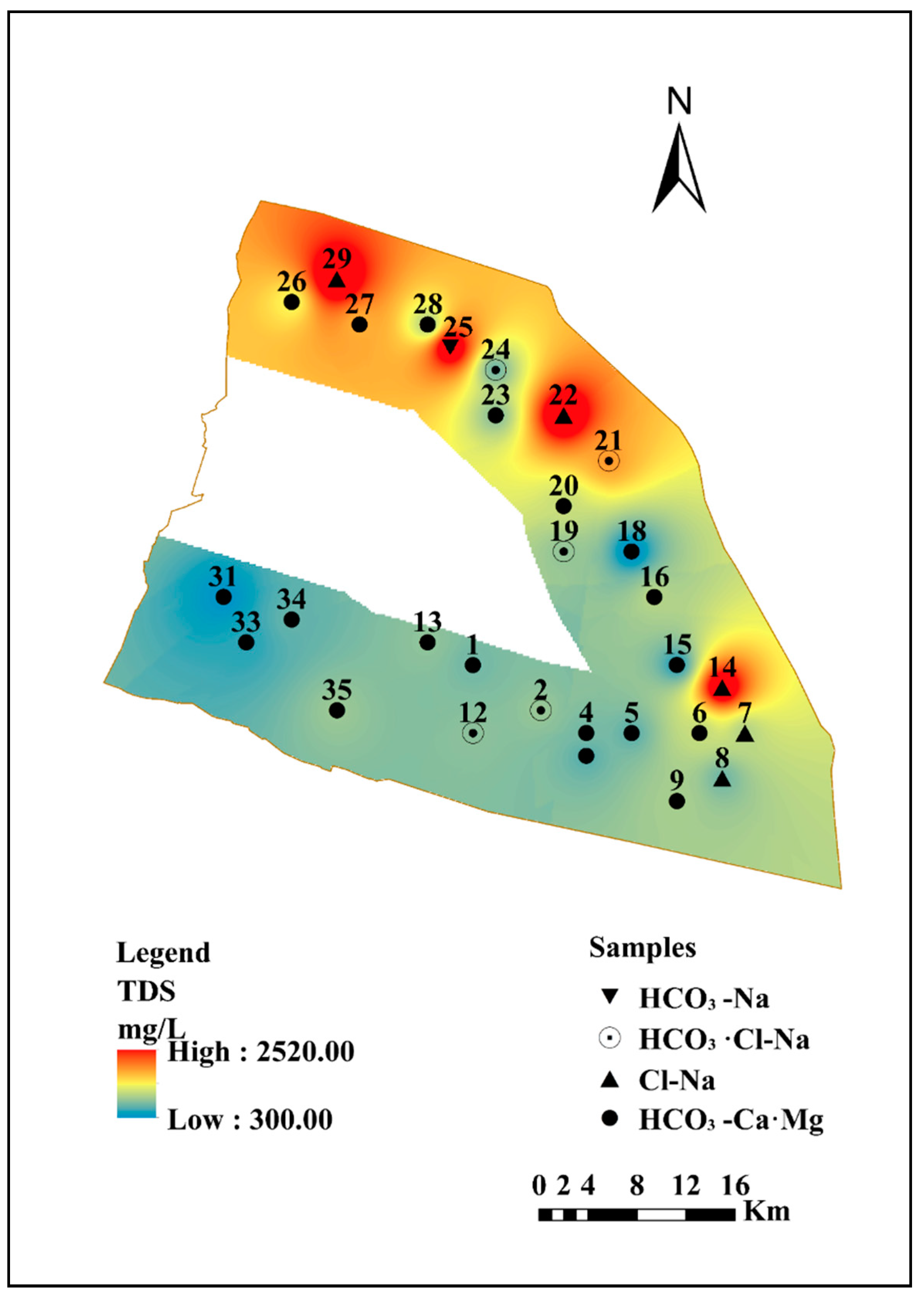
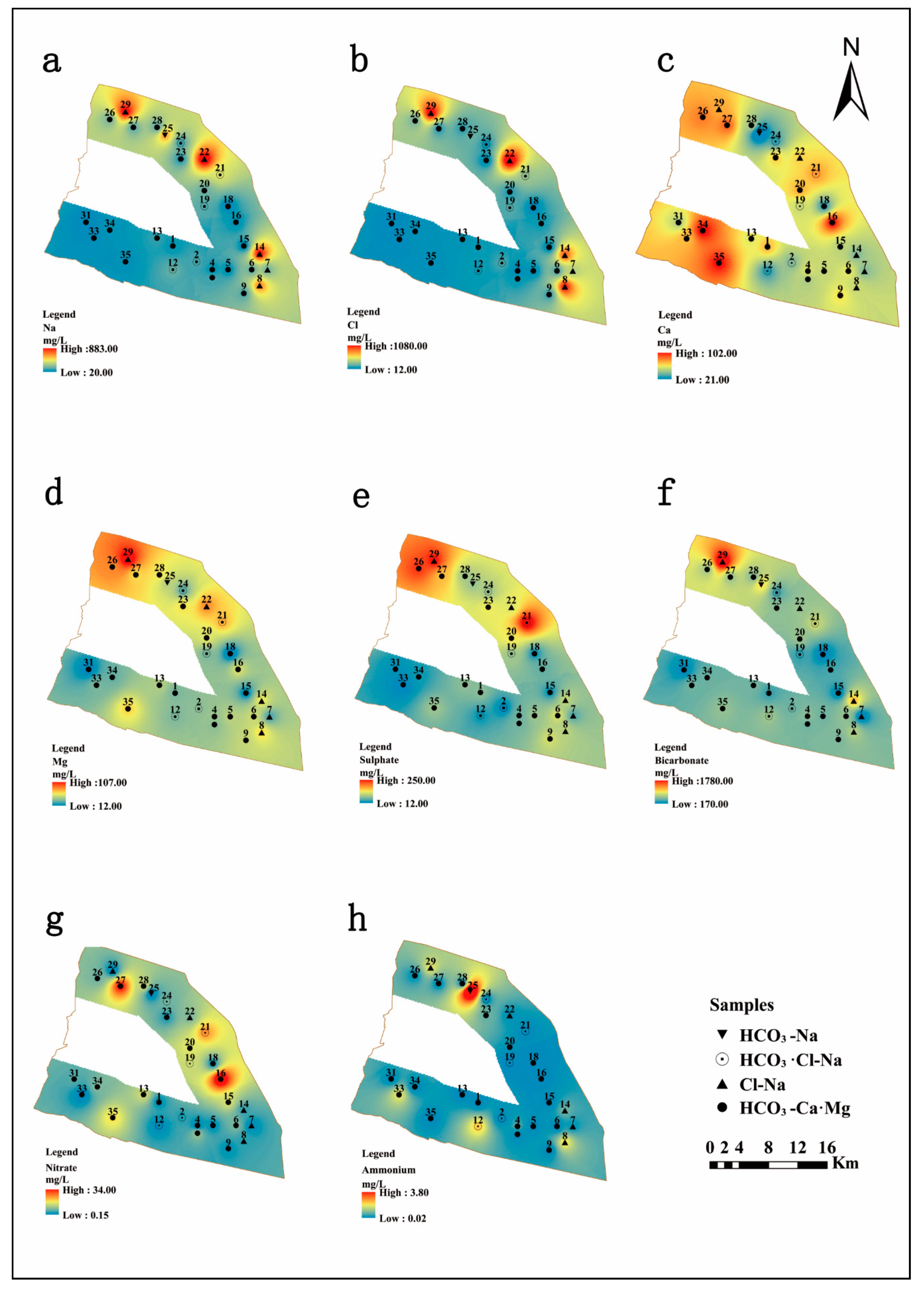
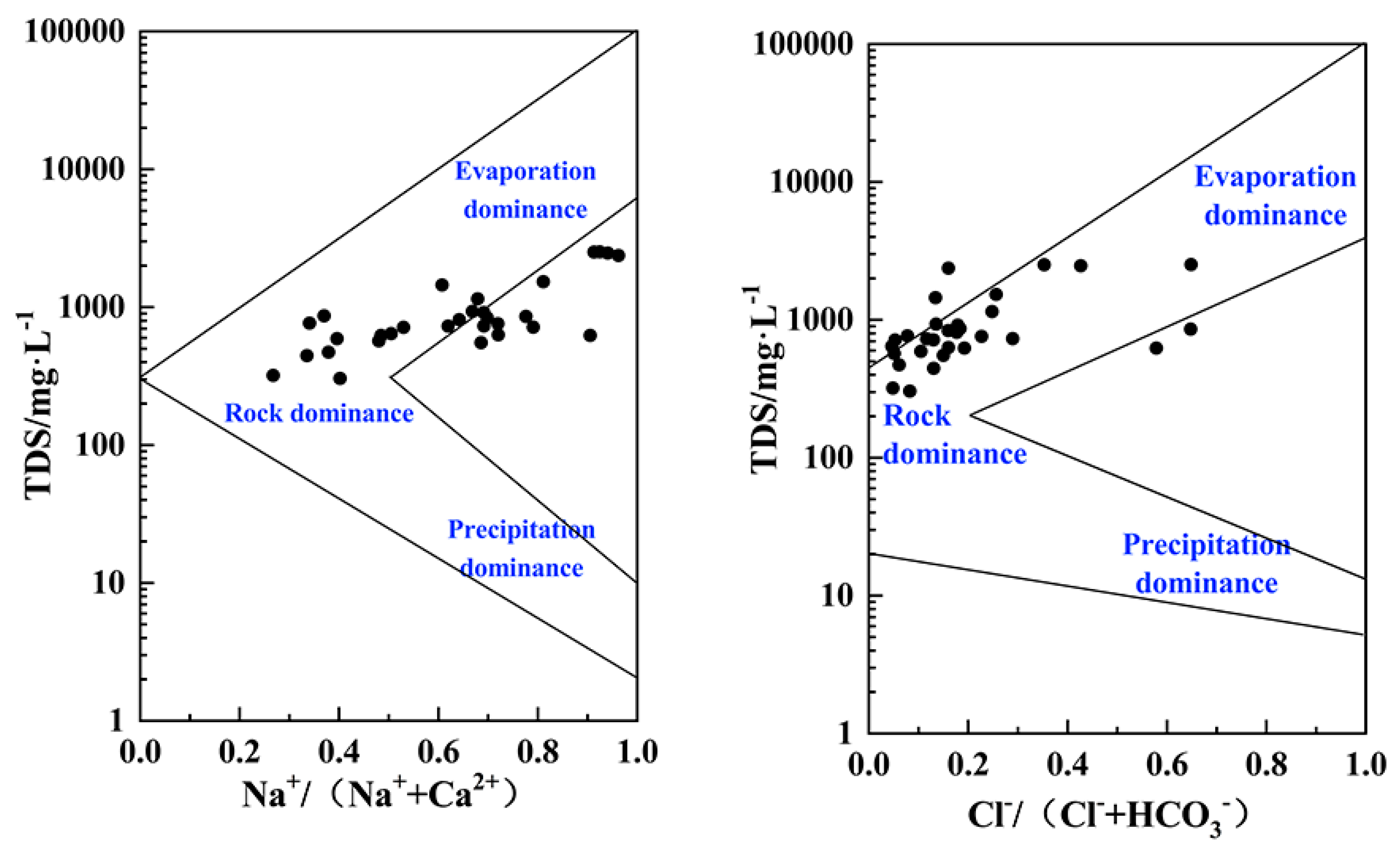
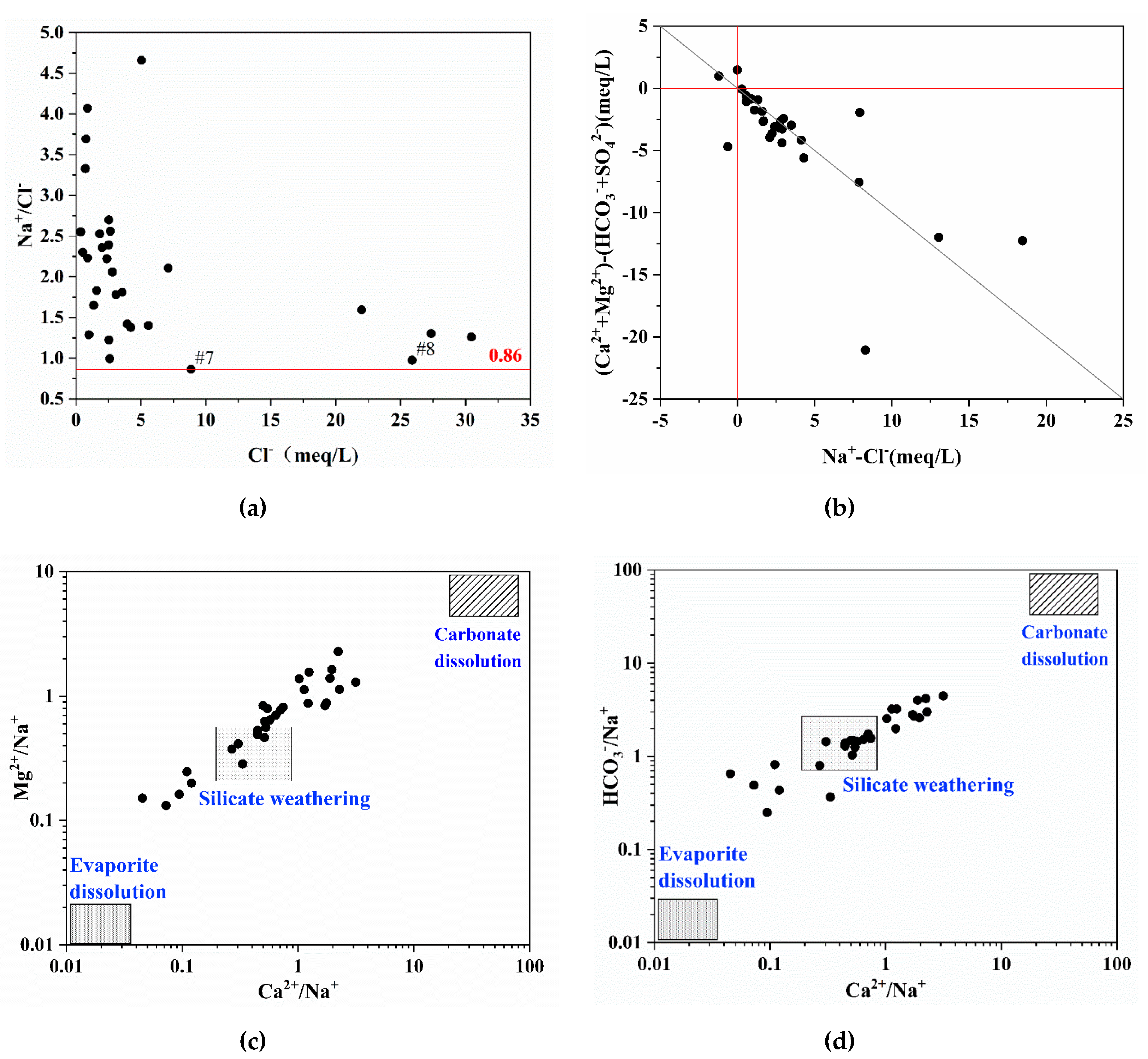
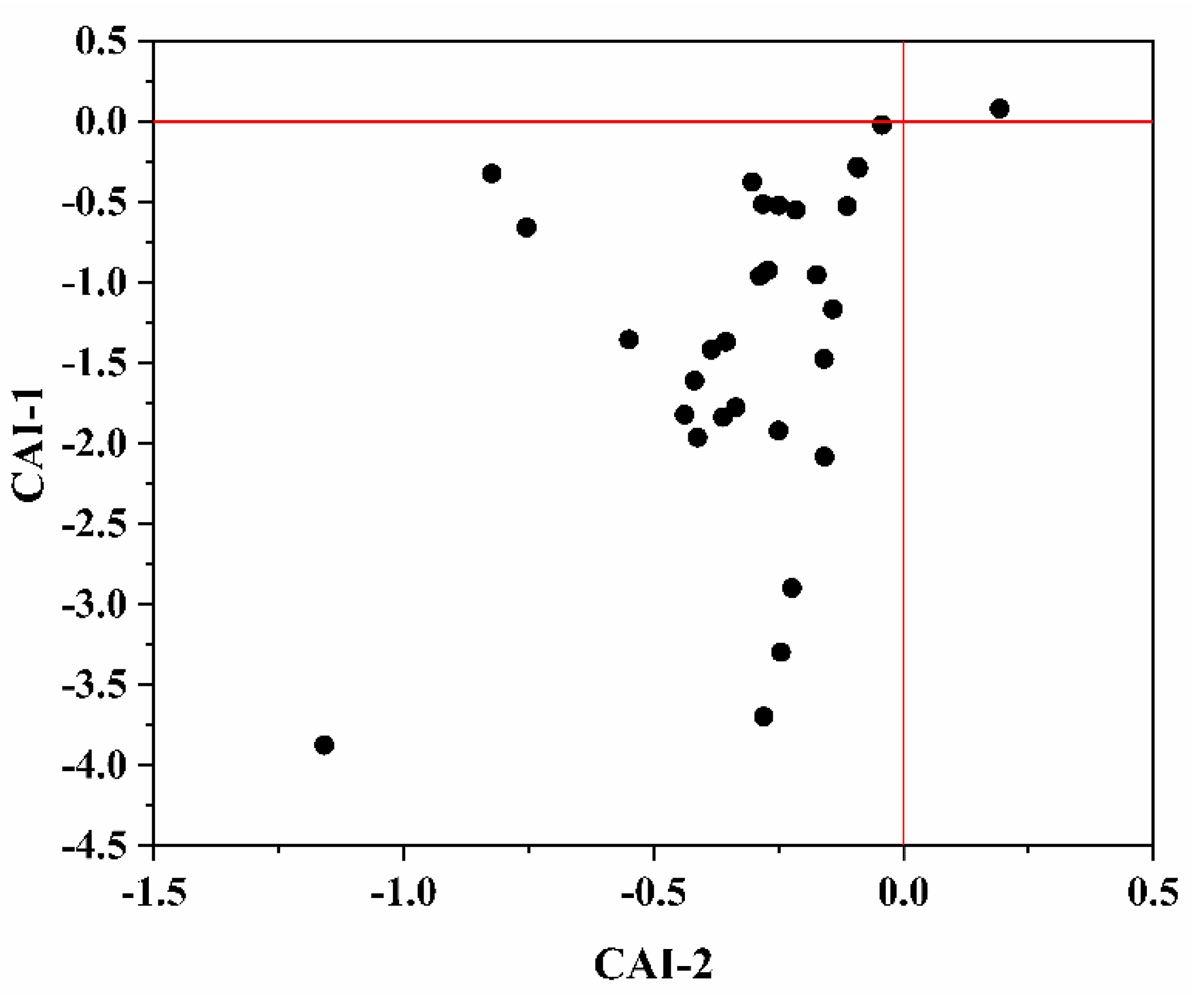
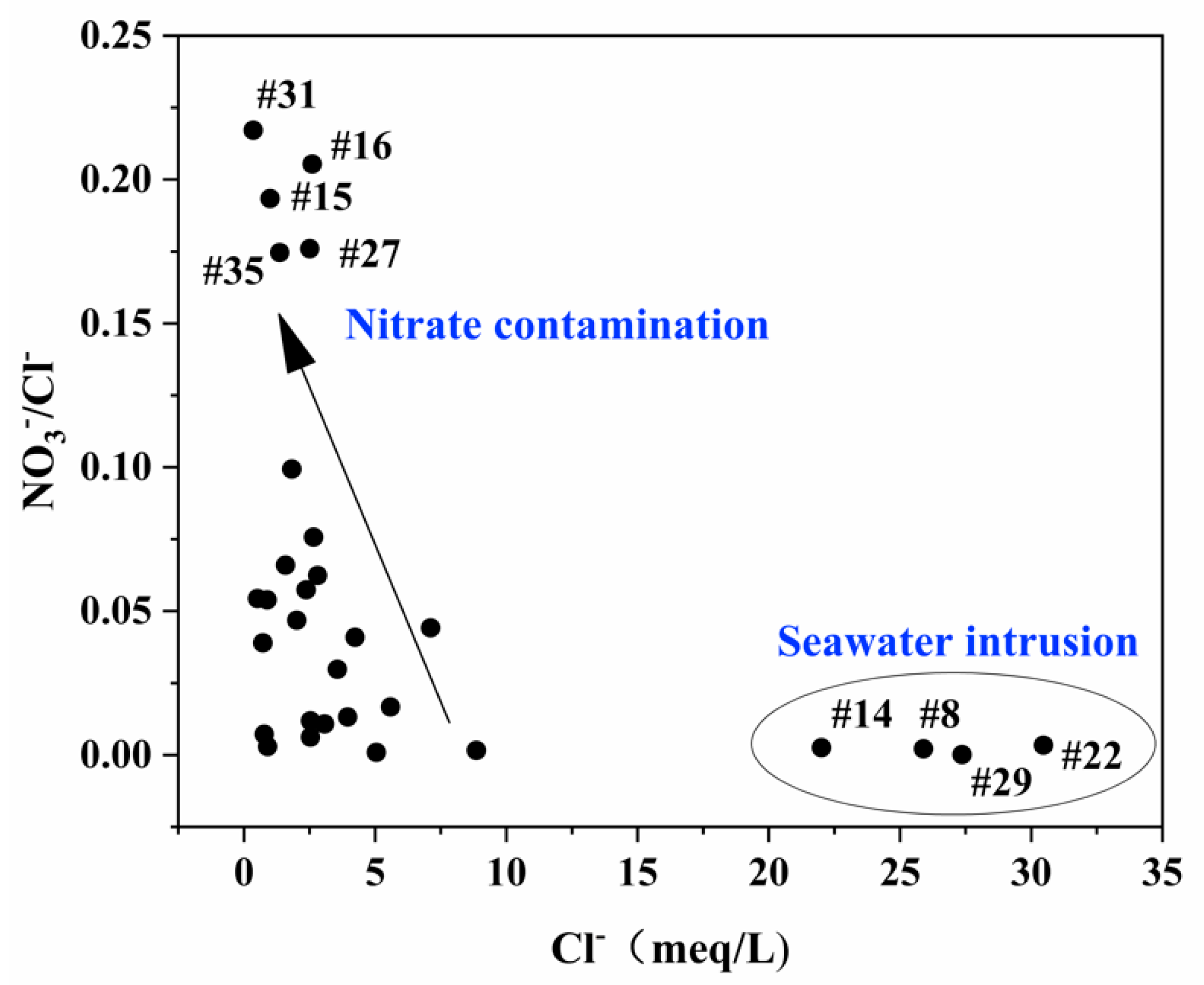
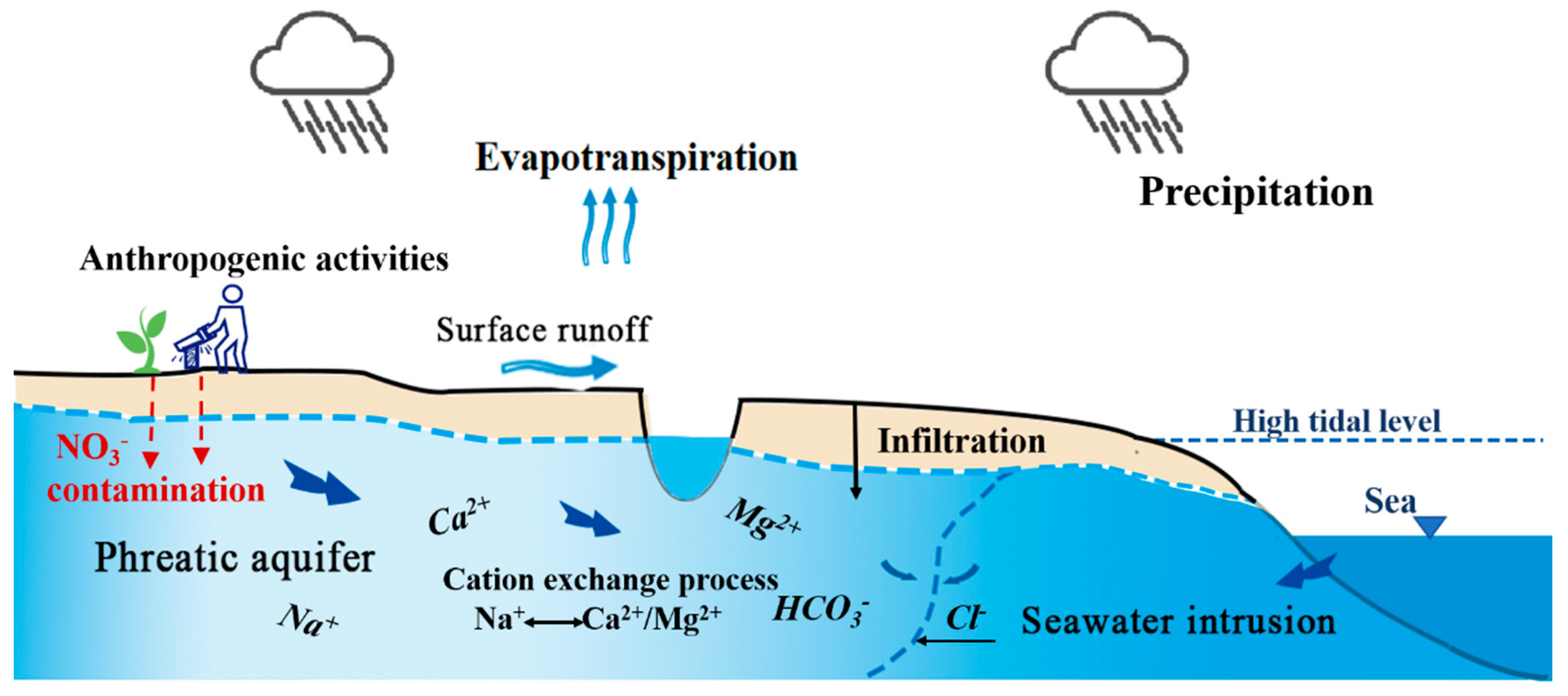
| Indicators | Mean Value | Standard Deviation | Minimum | Maximum | Variance (%) |
|---|---|---|---|---|---|
| T (℃) | 24.03 | 0.96 | 22.0 | 25.6 | 4.00 |
| pH | 8.00 | 0.12 | 7.79 | 8.19 | 1.50 |
| TH (mg/L) | 383.91 | 127.98 | 152.15 | 708.71 | 33.30 |
| TDS (mg/L) | 981.03 | 650.62 | 305.00 | 2520.00 | 66.30 |
| Na+ (mg/L) | 212.18 | 248.68 | 20.90 | 883.00 | 117.20 |
| K+ (mg/L) | 28.09 | 20.08 | 5.39 | 76.30 | 71.50 |
| Ca2+ (mg/L) | 66.13 | 18.85 | 21.30 | 102.00 | 28.50 |
| Mg2+ (mg/L) | 46.43 | 20.33 | 12.20 | 107.00 | 43.80 |
| Cl− (mg/L) | 209.23 | 300.95 | 12.62 | 1080.00 | 143.80 |
| HCO3− (mg/L) | 557.13 | 297.53 | 170.85 | 1780.00 | 53.40 |
| SO42− (mg/L) | 83.93 | 58.12 | 12.54 | 250.00 | 69.20 |
| NO3− (mg/L) | 7.32 | 7.96 | 0.16 | 33.08 | 108.70 |
| NH4+ (mg/L) | 0.36 | 0.75 | 0.01 | 3.73 | 208.30 |
| NO2− (mg/L) | 0.158 | 0.296 | 0.0025 | 1.490 | 187.79 |
| Fe2+ (mg/L) | 0.290 | 0.60 | 0.025 | 3.110 | 207.06 |
| Mn2+ (mg/L) | 0.108 | 0.14 | 0.002 | 0.654 | 131.97 |
| Cu2+ (mg/L) | 0.0020 | 0.0028 | 0.00005 | 0.0138 | 142.45 |
| Al3+ (mg/L) | 0.214 | 0.198 | 0.0003 | 0.061 | 92.87 |
| Zn2+ (mg/L) | 0.012 | 0.011 | 0.003 | 0.051 | 95.57 |
| Hg2+ (mg/L) | 0.00011 | 0.00006 | 0.00005 | 0.00023 | 54.54 |
| Pb2+ (mg/L) | 0.00032 | 0.00024 | 0.00003 | 0.00129 | 74.77 |
| As3+ (mg/L) | 0.0033 | 0.0074 | 0.00004 | 0.0354 | 223.119 |
| Cd2+ (mg/L) | 0.00013 | 0.000031 | 0.000066 | 0.00018 | 24.75 |
| Cr6+ (mg/L) | ND | ND | ND | ND | - |
| F− (mg/L) | 0.414 | 0.141 | 0.21 | 0.91 | 33.98 |
| IB error (%) | 0.36 | 4.20 | −9.71 | 8.60 | - |
| pH | TH | TDS | Na+ | K+ | Ca2+ | Mg2+ | Cl− | HCO3− | SO42− | NO3− | NH4+ | NO2− | Fe2+ | Mn2+ | Cu2+ | Al3+ | Zn2+ | Hg2+ | Pb2+ | As3+ | Cd2+ | F− | |
|---|---|---|---|---|---|---|---|---|---|---|---|---|---|---|---|---|---|---|---|---|---|---|---|
| pH | 1.000 | −0.265 | 0.011 | 0.064 | 0.019 | −0.137 | −0.203 | 0.118 | −0.065 | 0.062 | 0.136 | −0.365* | −0.211 | −0.185 | −0.591 | 0.149 | 0.518 | 0.426 | −0.017 | 0.427 | −0.118 | 0.056 | 0.389 |
| TH | 1.000 | 0.612 | 0.434 | 0.677 | 0.772 | 0.919 | 0.414 | 0.676 | 0.766 | 0.272 | 0.106 | −0.205 | −0.126 | 0.415 | −0.193 | −0.616 | −0.324 | −0.103 | −0.374 | 0.006 | 0.150 | 0.044 | |
| TDS | 1.000 | 0.788 | 0.829 | 0.261 | 0.708 | 0.768 | 0.677 | 0.683 | 0.183 | 0.194 | 0.056 | −0.127 | 0.258 | −0.044 | −0.273 | −0.097 | −0.145 | 0.042 | 0.172 | 0.376 | 0.406 | ||
| Na+ | 1.000 | 0.747 | −0.036 | 0.575 | 0.911 | 0.707 | 0.616 | −0.052 | 0.340 | 0.279 | 0.146 | 0.175 | −0.021 | −0.187 | −0.222 | −0.092 | −0.025 | 0.301 | 0.463 | 0.353 | |||
| K+ | 1.000 | 0.228 | 0.808 | 0.693 | 0.700 | 0.778 | 0.252 | 0.272 | 0.127 | −0.097 | 0.301 | 0.032 | −0.305 | −0.276 | 0.004 | 0.017 | 0.013 | 0.571 | 0.548 | ||||
| Ca2+ | 1.000 | 0.529 | 0.038 | 0.253 | 0.429 | 0.406 | −0.146 | −0.535 | −0.254 | 0.122 | −0.099 | −0.317 | 0.068 | −0.137 | −0.204 | −0.213 | −0.074 | −0.142 | |||||
| Mg2+ | 1.000 | 0.515 | 0.786 | 0.821 | 0.233 | 0.178 | −0.054 | −0.093 | 0.402 | −0.225 | −0.669 | −0.446 | −0.028 | −0.370 | 0.112 | 0.251 | 0.156 | ||||||
| Cl− | 1.000 | 0.531 | 0.491 | 0.019 | 0.239 | 0.075 | 0.002 | 0.066 | 0.031 | −0.147 | −0.086 | −0.094 | −0.136 | 0.253 | 0.361 | 0.381 | |||||||
| HCO3- | 1.000 | 0.666 | −0.041 | 0.412 | 0.163 | 0.242 | 0.349 | −0.273 | −0.403 | −0.362 | 0.045 | −0.171 | 0.321 | 0.245 | 0.218 | ||||||||
| SO42− | 1.000 | 0.245 | −0.068 | −0.090 | −0.204 | 0.241 | −0.101 | −0.489 | −0.336 | −0.152 | −0.074 | −0.112 | 0.419 | 0.275 | |||||||||
| NO3- | 1.000 | −0.493 | −0.465 | −0.746 | −0.418 | 0.682 | 0.010 | 0.251 | −0.082 | 0.232 | −0.703 | 0.088 | 0.081 | ||||||||||
| NH4+ | 1.000 | 0.668 | 0.683 | 0.545 | −0.345 | 0.002 | −0.354 | 0.103 | −0.098 | 0.515 | 0.283 | 0.208 | |||||||||||
| NO2− | 1.000 | 0.549 | 0.329 | −0.175 | 0.071 | −0.287 | −0.087 | 0.091 | 0.480 | 0.311 | 0.091 | ||||||||||||
| Fe2+ | 1.000 | 0.409 | −0.560 | 0.063 | −0.218 | 0.076 | −0.105 | 0.591 | 0.126 | 0.032 | |||||||||||||
| Mn2+ | 1.000 | −0.499 | −0.494 | −0.475 | 0.097 | −0.330 | 0.359 | 0.045 | −0.046 | ||||||||||||||
| Cu2+ | 1.000 | 0.358 | 0.394 | −0.240 | 0.447 | −0.628 | 0.065 | 0.204 | |||||||||||||||
| Al3+ | 1.000 | 0.644 | −0.180 | 0.630 | −0.172 | 0.053 | 0.259 | ||||||||||||||||
| Zn2+ | 1.000 | −0.185 | 0.330 | −0.105 | −0.246 | 0.169 | |||||||||||||||||
| Hg2+ | 1.000 | −0.079 | 0.138 | 0.024 | 0.005 | ||||||||||||||||||
| Pb2+ | 1.000 | −0.368 | 0.374 | 0.277 | |||||||||||||||||||
| As3+ | 1.000 | −0.098 | −0.083 | ||||||||||||||||||||
| Cd2+ | 1.000 | 0.488 | |||||||||||||||||||||
| F− | 1.000 |
| Parameters | WHO [60] | Percentage of Samples Exceeding | |
|---|---|---|---|
| (mg/L) | Desirable Limit | Maximum Allowable Limit | (%) |
| pH | 7–8.5 | 9.2 | Nil |
| TH | 100 | 500 | 23.3 |
| TDS | 500 | 1500 | 16.7 |
| Na | - | 200 | 20.0 |
| K | - | 12 | 40.0 |
| Ca | 75 | 200 | Nil |
| Mg | 50 | 150 | Nil |
| Cl | 250 | 600 | 13.3 |
| SO42− | 200 | 400 | Nil |
| NO3- | 50 | - | Nil |
| NH4+ | 1.5 | - | 3.3 |
| NO2− | 3 | - | Nil |
| Fe | - | 0.3 | 20.0 |
| Mn | - | 0.1 | 30.0 |
| Cu | - | 2.0 | Nil |
| Al | - | 0.1 | Nil |
| Zn | - | 3.0 | Nil |
| Hg | - | 0.001 | Nil |
| Pb | - | 0.01 | Nil |
| As | - | 0.01 | 6.7 |
| Cd | - | 0.003 | Nil |
| Cr | - | 0.05 | Nil |
| F | - | 1.5 | Nil |
| Quality Parameter | Ranges | Categories | Percent of Samples |
|---|---|---|---|
| TDS (mg/L) | <500 | Desirable for drinking | 13.33 |
| 500–1000 | Permissible for drinking | 63.33 | |
| 1000–3000 | Useful for irrigation | 23.33 | |
| >3000 | Unfit for drinking and irrigation | Nil | |
| Total hardness (mg/L) | <75 | Soft | Nil |
| 75–150 | Moderately hard | Nil | |
| 150–300 | Hard | 30.00 | |
| >300 | Very hard | 70.00 | |
| SAR | <10 | Excellent | 83.33 |
| 10–18 | Good | 13.33 | |
| 18–26 | Doubtful | 3.33 | |
| >26 | Unsuitable | Nil | |
| SSP | <20 | Excellent | 6.67 |
| 20–40 | Good | 40.00 | |
| 40–60 | Permissible | 36.67 | |
| 60–80 | Doubtful | 10.00 | |
| >80 | Unsuitable | 6.67 |
© 2020 by the authors. Licensee MDPI, Basel, Switzerland. This article is an open access article distributed under the terms and conditions of the Creative Commons Attribution (CC BY) license (http://creativecommons.org/licenses/by/4.0/).
Share and Cite
Wen, Y.; Qiu, J.; Cheng, S.; Xu, C.; Gao, X. Hydrochemical Evolution Mechanisms of Shallow Groundwater and Its Quality Assessment in the Estuarine Coastal Zone: A Case Study of Qidong, China. Int. J. Environ. Res. Public Health 2020, 17, 3382. https://doi.org/10.3390/ijerph17103382
Wen Y, Qiu J, Cheng S, Xu C, Gao X. Hydrochemical Evolution Mechanisms of Shallow Groundwater and Its Quality Assessment in the Estuarine Coastal Zone: A Case Study of Qidong, China. International Journal of Environmental Research and Public Health. 2020; 17(10):3382. https://doi.org/10.3390/ijerph17103382
Chicago/Turabian StyleWen, Yao, Jiahao Qiu, Si Cheng, Changchang Xu, and Xiaojiang Gao. 2020. "Hydrochemical Evolution Mechanisms of Shallow Groundwater and Its Quality Assessment in the Estuarine Coastal Zone: A Case Study of Qidong, China" International Journal of Environmental Research and Public Health 17, no. 10: 3382. https://doi.org/10.3390/ijerph17103382
APA StyleWen, Y., Qiu, J., Cheng, S., Xu, C., & Gao, X. (2020). Hydrochemical Evolution Mechanisms of Shallow Groundwater and Its Quality Assessment in the Estuarine Coastal Zone: A Case Study of Qidong, China. International Journal of Environmental Research and Public Health, 17(10), 3382. https://doi.org/10.3390/ijerph17103382




